|
The Stairway to Heaven
Let us imagine ourselves in the Pharaoh's magnificent funerary
temple. Having mummified and prepared the Pharaoh for his Journey,
the Shem priests now intone the Gods to open for the king a path and
a gateway. The divine messenger has arrived on the other side of the
false door, ready to take the Pharaoh through the stone wall and
launch him on his journey.
Emerging through the false door on the eastern side of his tomb, the
Pharaoh was instructed to set his course eastward. Lest he
misunderstand, he was explicitly warned against going west: "Those
who go thither, they return not!" His goal was the Duat, in the
"Land of the Mountain Gods." He was to enter there "The Great House
of Two ... the House of Fire"; where, during "a night of computing
years," he shall be transformed into a Divine Being and ascend "to
the east side of Heaven."
The first obstacle in the Pharaoh's course was the Lake of Reeds—a
long body of marshy waters made up of a series of adjoining lakes.
Symbolically, he had the blessing of his guardian God to cross the
lake by parting its waters (Fig. 13); physically, the crossing was
possible because the lake was served by the Divine Ferryman, who
ferried the Gods across in a boat made by Khnum, the Divine
Craftsman. But the Ferryman was stationed on the far side of the
lake, and the Pharaoh had a hard time convincing him that he was
entitled to be fetched and ferried over.
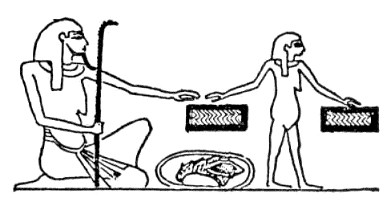
Fig. 13
The Ferryman questioned the Pharaoh about his origins. Was he the
son of a God or Goddess? Was he listed in the "Register of the Two
Great Gods"? The Pharaoh explained his claims to being of "divine
seed," and gave assurances of his righteousness. In some cases it
worked.
In other instances the Pharaoh had to appeal to Ra or to Thoth to get him across; in which instances, the boat and its oars
or rudder came alive with uncanny forces: the ferryboat began to
move by itself, the steering-oar grasped by the king directed
itself. All, in short, became self-propelled. One way or another,
the Pharaoh managed to cross the lake and be on his way toward "The
Two That Bring Closer the Heavens":
He descends into the boat, like Ra,
on the shores of the Winding Watercourse.
The king rows in the Hanbu-boat;
He takes the helm toward the
Plain of "The Two That Bring Closer the Heavens,"
in the land beginning from the Lake of Reeds.
The Lake of Reeds was situated at the eastern end of the domain of
Horus. Beyond lay the territories of his adversary Seth, the "lands
of Asia." As would be expected on such a sensitive boundary, the
king discovers that the lake's eastern shore is patrolled by four
"Crossing guards, the wearers of side locks." The way these guards
wore their hair was truly their most conspicuous feature. "Black as
coal," it was "arranged in curls on their foreheads, at their
temples and at the back of their heads, with braids in the center of
their heads."
Combining diplomacy with firmness, the king again proclaimed his
divine origins, claiming he was summoned by "my father Ra." One
Pharaoh is reported to have used threats: "Delay my crossing, and I
will pluck out your locks as lotus flowers are plucked in the lotus
pond!" Another had some of the Gods come to his assistance. One way
or another, the Pharaoh managed to proceed.
The king has now left the lands of Horus. The eastward place which
he seeks to reach—though under the aegis of Ra—is "in the region of
Seth." His goal is a mountainous area, the Mountains of the East
(Fig. 14).
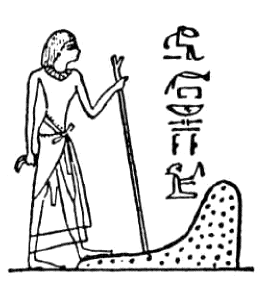
Fig. 14
His course is set toward a pass between two mountains,
"the two mountains which stand in awe of Seth." But first he has to
traverse an arid and barren area, a kind of no-God's land between
the domains of Horus and Seth. Just as the pace and urgency of the
Utterances increase, for the king is getting closer to the Hidden
Place where the Doors of Heaven are located, he is challenged again
by guards. "Where goest thou?" they demand to know.
The king's sponsors answer for him:
"The king goes to Heaven, to
possess life and joy; that the king may see his father, that the
king may see Ra."
As the guards contemplate the request, the king
himself pleads with them:
"Open the frontier ... incline its
barrier ... let me pass as the Gods pass through!"
Having come from Egypt, from the domain of Horus, the king and his
sponsors recognize the need for prudence. Many Utterances and verses
are employed to present the king as neutral in the feud between the
Gods. The king is introduced both as "born of Horus, he at whose
name the Earth quakes," and as "conceived by Seth, he at whose name
Heaven trembles."
The king stresses not only his affinity to
Ra, but
declares that he proceeds "in the service of Ra"; producing thereby
a laissez-passer from higher authority. With shrewd evenhandedness,
the texts point out to the two Gods their own self-interest in the
king's continued journey, for Ra would surely appreciate their aid
to one who comes in his service.
Finally, the guards of the Land of Seth let the king proceed toward
a mountain pass. The king's sponsors make sure that he realizes the
import of the moment:
Thou are now on the way to the high places
In the land of Seth.
In the
land of Seth
Thou will be set on the high places,
On that high Tree of
the Eastern Sky
On which the Gods sit.
The king has arrived at the Duat.
The Duat was conceived as a completely enclosed Circle of the Gods
(see Fig. 15), at the head-point of which there was an opening to
the skies (symbolized by the Goddess Nut) through which the
Imperishable Star (symbolized by the Celestial Disk) could be
reached. Other sources suggested in reality a more oblong or oval
valley, enclosed by mountains. A river which divided into many
streams flowed through this land, but it was hardly navigable and
most of the time Ra's barge had to be towed, or moved by its own
power as a "boat of earth," as a sled.
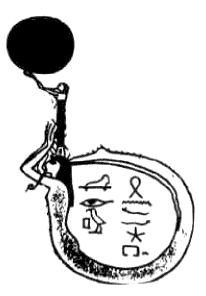
Fig. 15
The Duat was divided into twelve divisions, variably described as
fields, plains, walled circles, caverns or halls, beginning above
ground and continuing underground. It took the departed king twelve
hours to journey through this enchanted and awesome realm; this he
could achieve, because Ra had put at his disposal his magical barge
or sled, in which the king traveled aided and protected by his
sponsoring Gods.
There were seven gaps or passes in the mountains that enclosed the
Duat, and two of them were in the mountains on the east side of
Egypt
(i.e. in the mountains on the west of the Duat), which were called
"The Horizon" or "The Horn" of "The Hidden Place." The pass through
which Ra had traveled was 220 atru (some twenty-seven miles) long,
and followed the course of a stream; the stream, however, ran dry
and Ra's barge had to be towed. The pass was guarded and had
fortifications "whose doors were strong."
The Pharaoh, as some papyri indicate, took the course leading
through the second, shorter pass (only some fifteen miles long). The
papyrus drawings show him upon the barge or sled of Ra, passing
between two mountain peaks on each of which there is stationed a
company of twelve guardian Gods. The texts describe a "Lake of
Boiling Waters" nearby— waters which, despite their fiery nature are
cool to the touch. A fire burns below the ground. The place has a
strong bituminous or "natron" stench which drives away the birds.
Yet not too far away, there is depicted an oasis with shrubs or low
trees around it.
Once across the pass, the king encounters other companies of Gods.
"Come in peace," they say. He has arrived at the second division.
It is called, after the stream that runs through it, Ur-nes (a name
which some scholars equate with Uranus, the Greek God of the skies).
Measuring some fifteen by thirty-nine miles, it is inhabited by
people with long hair, who eat the flesh of their asses and depend
on the Gods for water and sustenance, for the place is arid and the
streams are mostly dry. Even Ra's barge turns here into a "boat of
earth." It is a domain associated with the Moon God, and with
Hathor,
the Goddess of Turquoise.
Aided by the Gods, the king passes safely through the second
division and in the Third Hour arrives at Net-Asar, "The Stream of
Osiris." Similar in size to the second division, this third division
is inhabited by "The Fighters." It is there that the four Gods, who
are in charge of the four cardinal points of the compass, are
stationed.
The pictorial depictions which accompanied the hieroglyphic texts
surprisingly showed the Stream of Osiris as meandering its way from
an agricultural area, through a chain of mountains, to where the
stream divided into tributaries. There, watched over by the
legendary Phoenix birds, the Stairway to Heaven was situated; there,
the Celestial Boat of Ra was depicted as sitting atop a mountain, or
rising heavenward upon streams of fire (Fig. 16).
Here, the pace of prayers and Utterances increases again. The king
invokes the "magical protectors," that "this man of Earth may enter
the Neter-Khert" unmolested. The king is nearing the heart of the
Duat; he is near the Atnen-Ta, the "Hidden Place."
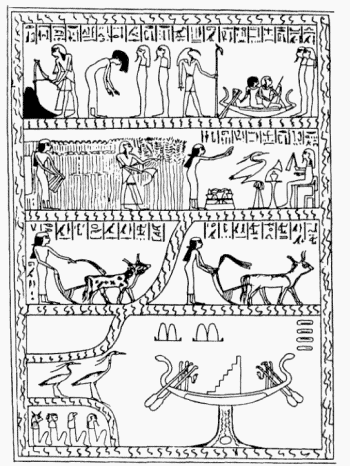
Fig.16
It was there that Osiris himself had risen to the Eternal Afterlife.
It was there that the "Two That Bring Closer the Heaven" stood out
"yonder against the sky," as two magical trees. The king offers a
prayer to Osiris (the Chapter's title in the
Book of the Dead is
"Chapter of Making His Name in the Neter-Khert Granted"):
May be given to me my Name
in the Great House of Two;
May in the House of Fire
my Name be granted.
In the night of computing years,
and of telling the months,
may I be a Divine Being,
may I sit at the east side of Heaven.
Let the God advance me from behind; Everlasting is his Name.
The king is within sight of the "Mountain of Light."
He has reached the STAIRWAY TO HEAVEN.
The
Pyramid Texts said of the place that it was "the stairway in
order to reach the heights." Its stairs were described as "the
stairs to the sky, which are laid out for the king, that he may
ascend thereon to the heavens." The hieroglyphic pictograph for the
Stairway to Heaven was sometimes a single
stairway (which was also cast in gold and worn as a charm), or more
often
a double stairway , as a step pyramid. This Stairway to Heaven was
constructed by the Gods of the city of An—the location of the
principal temple of Ra—so that they, the Gods, could be "united with
the Above."
The king's goal is the Celestial Ladder, an Ascender which would
actually carry him aloft. But to reach it in the House of Fire, the
Great House of Two, he must enter the Amen-Ta, the Hidden Land of
Seker, God of the Wilderness.
It is a domain described as a fortified circle. It is the
subterranean Land of Darkness, reachable by entering into a mountain
and going down spiraling hidden paths protected by secret doors. It
is the fourth division of the Duat which the king must now enter;
but the mountain entrance is protected by two walls and the passage
between them is swept by flames and manned by guarding Gods.
When Ra himself had arrived at this entrance to the Hidden Place,
"he performed the designs"—followed the procedures—"of the Gods who
are therein by means of his voice, without seeing them." But can the
king's voice alone achieve for him admission? The texts remind the
challenger that only "he who knoweth the plan of the hidden
shaftways which are in the Land of Seker," shall have the ability to
journey through the Place of Underground Passages and eat the bread
of the Gods.
Once again the king offers his credentials. "I am the Bull, a son of
the ancestors of Osiris," he announces. Then the Gods who sponsor
him, pronounce in his behalf the crucial words for admission:
Admittance is not refused thee
At the gate of the Duat;
The folding
doors of the Mountain of Light
Are opened to thee;
The bolts open to
thee of themselves.
Thou treadest the Hall of the Two Truths;
The God
who is in it greets thee.
The right formula or password having thus been pronounced, a God
named Sa uttered a command; at his word, the flames ceased, the
guards withdrew, the doors opened automatically, and the Pharaoh was
admitted into the subterranean world.
"The mouth of the earth opens for thee, the eastern door of heaven
is open for thee," the Gods of the Duat announce to the king. He is
reassured that though he enters the mouth of the earth, it is indeed
the Gateway to Heaven, the coveted eastern door.
The journey in the fourth and following Hours leads the king through
caverns and tunnels where Gods of diverse functions are sometimes
seen, sometimes only heard. There are underground canals, on which
Gods move about in soundless barques. There are eerie lights,
phosphorous waters, torches that light the way. Mystified and
terrified, the king moves on, toward "the pillars that reach the
Heaven."
The Gods seen along the way are mostly organized in groups of
twelve, and bear such epithets as "Gods of the Mountain," "Gods of
the Mountain of the Hidden Land," or "The Holders of the Time of
Life in the Hidden Land." The drawings that accompanied some of the
ancient texts provide identification of these Gods through the
different scepters held by them, their particular headgear, or by
depicting their animal attributes—hawk-headed, jackal-headed,
lion-headed. Serpents also make an appearance, representing
subterranean guards or servants of the Gods in the Hidden Land.
The texts and the ancient illustrations suggest that the king has
entered a circular underground complex, within which a vast tunnel
first spirals down and then up. The depictions, presented in a
cross-section fashion, show a gradually sloping tunnel some forty
feet high, with a smooth ceiling and a smooth floor, both made of
some solid material two to three feet thick. The tunnel is
partitioned into three levels, and the king moves within the middle
level or corridor. The upper and lower levels are occupied by Gods,
serpents and structures of diverse functions.
The king's sled, pulled by four Gods, begins its journey by gliding
silently along the middle corridor; only a beam emitted from the
vehicle's bow lights the way. But soon the passage is blocked by a
sharply slanting partition, and the king must get off and continue
on foot.
The partition, as the cross-section depictions show, is one wall of
a shaft that cuts across the three tunnel levels (which slope at
about 15°) at a sharper angle of some 40°. It apparently begins
above the tunnel, perhaps at ground level or somewhere higher within
the mountain; it seems to end as it reaches the floor of the lowest,
third level. It is called Re-Stau, "The Path of the Hidden Doors";
and at the first and second levels, it is indeed provided with
chambers that look like air-locks.
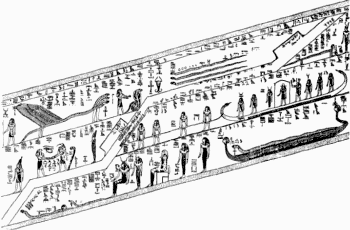
Fig. 17
These chambers enable Seker and
other "hidden Gods" to pass through, though "the door has no
leaves." The king, who has left his sled, mysteriously passes
through this slanting wall simply by virtue of the command of some
God, whose voice
had activated the air-lock. He is greeted on the other side by
representatives of Horus and Thoth, and is passed along from God to
God. (Fig. 17.) On his way down, the king sees "faceless Gods"—Gods
whose faces cannot be seen. Offended or simply curious, he pleads
with them:
Uncover your faces,
take off your head coverings,
when ye meet me;
For, behold, I [too] am a mighty God
come to be among you.
But they do not heed his plea to show their faces; and the texts
explain that even they,
"these hidden beings, neither see nor look
upon" their own chief, the God Seker "when he is in this form
himself, when he is inside his abode in the earth."
Spiraling his way down, the king passes through a door and finds
himself on the third, lowest level. He enters an antechamber which
bears the emblem of the Celestial Disk, and is greeted by the God
who is "The Messenger of Heaven" and a Goddess who wears the
feathered emblem of Shu. "He who rested the sky upon the Stairway to
Heaven" (Fig. 18).
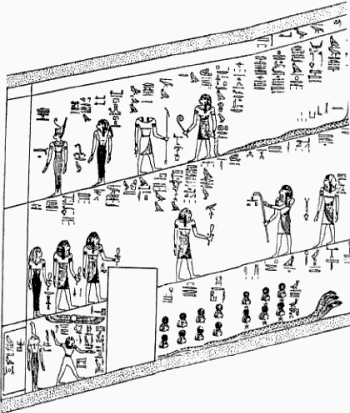
Fig.18
As called for by the formula in the Book of the
Dead, the king proclaims:
Hail, two children of Shu!
Hail,
children of the Place Of The Horizon ...
May I ascend?
May I journey forth like Osiris?
The answer must be positive, for the king is admitted by them,
through a massive door, into the shafts which only the hidden Gods
use.
In the Fifth Hour, the Pharaoh reaches the deepest subterranean
parts which are the secret ways of Seker. Following shafts that
incline up, over and down, the Pharaoh cannot see Seker; but the
cross-section drawings depict the God as a hawk-headed person,
standing upon a serpent and holding two wings within a completely
enclosed oval structure deep underground, guarded by two sphinxes.
Though the king cannot see this chamber, he hears coming from it "a
mighty noise, like that heard in the heights of the heavens when
they are disturbed by a storm." From the sealed chamber there flows
a subterranean pool whose "waters are like fire."
Chamber and pool
alike are in turn enclosed by a bunkerlike structure, with a
compartmentalized air-lock on the left side and a huge door on the
right side. As further protection, a mound of soil is piled up atop
the sealed chamber. The mound is topped by a Goddess, whose head
only is seen, protruding into the descending corridor. A beetle
symbol (meaning "to roll, to come into being") connects the head of
the Goddess with a conical chamber or object in the uppermost
corridor (Fig. 19); two birds are perched upon it.
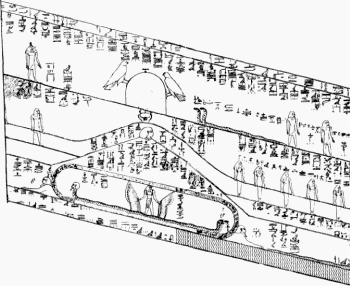
Fig. 19
The texts and symbols inform us that, though Seker was hidden, his
presence could be made known even in the darkness, because of a
glowing "through the head and eyes of the great God, whose flesh
radiates forth light." The triple arrangement—Goddess, beetle
(Kheper) and conical object or chamber—apparently served to enable
the hidden God to be informed of what goes on outside his
hermetically sealed chamber.
The hieroglyphic text adjoining the
beetle symbol states:
"Behold Kheper who, immediately the (boat?) is
towed to the top of this circle, connects himself with the ways of
the Duat. When this God standeth on the head of the Goddess, he
speaks words to Seker every day."
The passage by the Pharaoh over the hidden chamber of Seker and by
the setup through which Seker was informed of such passage, was
deemed a crucial phase in his progress. The Egyptians were not the
only ones in antiquity who believed that each departed person faced
a moment of judgment, a spot where their deeds or hearts would be
weighed and evaluated and their soul or Double either condemned to
the Fiery Waters of Hell, or blessed to enjoy the cool and
lifegiving waters of Paradise. By ancient accounts, here was such a
Moment of Truth for the Pharaoh.
Speaking for the Lord of the Duat, the Goddess whose head only was
seen announced to the Pharaoh the favorable decision:
"Come in peace
to the Duat ... advance in thy boat on the road which is in the
earth."
Naming
herself Ament (the female Hidden One), she added:
"Ament calls to
thee, so that thou mayest go forward in the sky, as the Great One
who is in the Horizon."
Passing the test, not dying a second time, the king was born again.
The way now led by a row of Gods whose task it was to punish the
condemned; but the king proceeds unharmed. He rejoins his boat or
sled; it is accompanied by a procession of Gods; one of them holds
the emblem of the Tree of Life (Fig. 20).
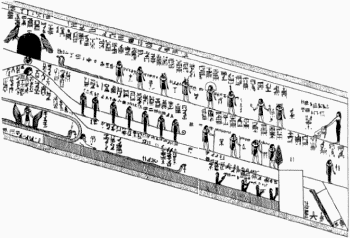
Fig. 20
The king has been found worthy of Afterlife.
Leaving the zone of Seker, the king enters the sixth division,
associated with Osiris. (In versions of the Book of the Gates, it
was in this Sixth Hour that Osiris judged the departed.)
Jackal-headed Gods "Who Open the Ways" invite the king to take a
refreshing dip in the subterranean pool or Lake of Life, as the
Great God himself had done when he passed here before. Other Gods,
"humming as bees," reside in cubicles whose doors fly open by
themselves as the king moves by. As he progresses, the epithets of
the Gods assume more technical aspects. There are the twelve Gods
"who hold the rope in the Duat," and the twelve "who hold the
measuring cord."
The sixth division is occupied by a series of chambers set close
together. A curving path is called "The Secret Path of the Hidden
Place." The king's boat is towed by Gods clad in leopard skins, just
as the Shem priests who performed the Opening of the Mouth
ceremonies were clad.
Is the king nearing the Opening or Mouth of the Mountain? In the
Book of the Dead, the chapters indeed now bear such titles as "The
chapter of sniffing the air and of getting power." His vehicle is
now,
"endowed with magical powers ... he journeyeth where there is no
stream and where
there are none to tow him; he performeth this by words of power"
which proceed from the mouth of a God.
As the king passes through a guarded gate into the seventh division,
the Gods and the surroundings lose their "underworld" aspects and
begin to assume celestial affiliations. The king encounters the
falcon-headed God Heru-Her-Khent, whose hieroglyphic name included
the stairway symbol and who wore on his head the Celestial Disk
emblem. His task is "to send the star-Gods on their way and to make
the constellation-Goddesses go on their way." These were a group of
twelve Gods and twelve Goddesses who were depicted with star
emblems. The incantations to them were addressed to "the starry
Gods"—
who are divine in flesh, whose magical powers have come into being ... who are united into your stars, who rise up for Ra ... Let
your stars guide his two hands so that he may journey to the Hidden
Place in peace.
In this division, there are also present two companies of Gods
associated with the Ben-ben, the mysterious object of Ra that was
kept at his temple in the city of An (Heliopolis). They "are those
who possess the mystery," guarding it inside the Het-Benben (The
Ren-ben House); and eight who guard outside but also "enter unto the
Hidden Object." Here there are also nine objects, set up in a row,
representing the symbol Shem which hieroglyphically meant
"Follower."
The king has indeed arrived in parts of the Duat associated with
An,
after whom Heliopolis was named. In the Ninth Hour, he sees the
resting place of the twelve "Divine Rowers of the Boat of Ra," they
who operate Ra's celestial "Roat of Millions of Years." In the Tenth
Hour, passing through a gate, the king enters a place astir with
activity. The task of the Gods there is to provide Flame and Fire to
the boat of Ra. One of the Gods is called "Captain of the Gods of
the boat." Two others are those "Who order the course of the stars."
They and other Gods are depicted with one, two or three star
symbols, as though showing some rank associated with the heavens.
Passing from the tenth to the eleventh division, the affinity to the
heavens rapidly increases. Gods bear the Celestial Disk and star
emblems. There are eight Goddesses with star emblems "who have come
from the abode of Ra." The king sees the "Star Lady" and the "Star
Lord," and Gods whose task it is to provide "power for emerging"
from the Duat, "to make the Object of Ra advance to the Hidden House
in the Upper Heavens."
In this place there are also Gods and Goddesses whose task it is to
equip the king for a celestial trip "over the sky." Together with
some Gods he is made to enter a "serpent" inside which he is to
"shed the skin" and emerge "in the form of a rejuvenated Ra." Some
of the terms here employed in the texts are still not understood,
but the process is clearly explained: the king,
having entered dressed as he came, emerges as a falcon, "equipped as
a God": the king "lays down on the ground the Mshdt-garment"; he
puts on his back the "Mark-garment"; he "takes his divine
Shuh-vestment" and he puts on "the collar of beloved Horus" which is
like "a collar on the neck of Ra." Having done all that, "the king
has established himself there as a God, like them." And he tells the
God who is with him: "If thou goest to Heaven, so will the king go
to Heaven."
The illustrations in the ancient texts depict here a group of Gods
dressed in unusual garb, like tightly fitting overalls adorned with
circular collar bands (Fig. 21).
They are led or directed by a God with the emblem of the Celestial
Disk upon his head, who stands with outstretched arms between the
wings of a serpent with four human legs. Against a starry
background, the God and the serpent face another serpent which,
though wingless, clearly flies as it carries aloft a seated Osiris.
(Fig. 22).
Having been properly equipped, the king is led to an opening in the
center of a semi-circular wall. He passes the hidden door. Now he
moves within a tunnel which is "1300 cubits long" called "Dawn at
the End." He reaches a vestibule; the emblems of the Winged Disk are
seen everywhere. He encounters Goddesses "who shed light upon the
road of Ra" and a magical scepter representing "Seth, the Watcher."
The Gods explain to the awed king:
This cavern is the broad hall of Osiris
Wherein the wind is
brought;
The north wind, refreshing,
Will raise thee, O king, as
Osiris.
It is now the twelfth division, the final Hour of the king's
subterranean journey. It is "the uttermost limit of the thick
darkness." The point which he has reached is named "Mountain of the
Ascent of Ra." The king looks up and is startled: the celestial boat
of Ra looms in front of his eyes, in all its awesome majesty.
He has reached an object which is called "The Ascender to the Sky."
Some texts suggest that Ra himself prepared the Ascender for the
king, "that the king may ascend upon it to the heavens"; other texts
say that the Ascender was made or set up by several other Gods. It
is "the Ascender which had carried Seth" heavenward. Osiris could
not reach the Firmament of Heaven except by means of such an
Ascender; thus the king too requires it in order to be translated,
as Osiris, to eternal life.
The Ascender or Divine Ladder was not a common ladder. It was bound
together by copper cables; "its sinews (like those) of the Bull of
Heaven." The "uprights at its sides" were covered over tightly with
a kind of "skin"; its rungs were "Shesha-hewn" (meaning unknown);
and "a great support (was) placed under it by He Who binds."
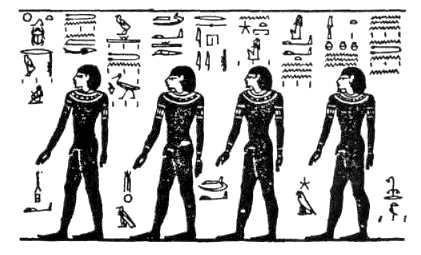
Fig. 21

Fig. 22
Illustrations to the Book of the Dead
showed such a Divine Ladder sometimes with the Ankh ("Life") sign
 symbolically reaching
toward the
Celestial Disk in the heavens—in the shape of a high tower with a
superstructure (Fig. 23a, b). In stylized form, the tower by itself
was
written hieroglyphic-ally symbolically reaching
toward the
Celestial Disk in the heavens—in the shape of a high tower with a
superstructure (Fig. 23a, b). In stylized form, the tower by itself
was
written hieroglyphic-ally  ("Ded") and meant "Everlastingness." It
was a
symbol most closely associated with Osiris, for a pair of such
pillars ("Ded") and meant "Everlastingness." It
was a
symbol most closely associated with Osiris, for a pair of such
pillars
 were said to have been erected in front of his principal temple at Abydos, to commemorate the two objects which stood in the Land of
Seker and made possible the ascent of Osiris heavenward. were said to have been erected in front of his principal temple at Abydos, to commemorate the two objects which stood in the Land of
Seker and made possible the ascent of Osiris heavenward.
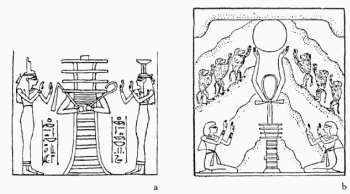
Fig. 23
A long Utterance in the Pyramid Texts is both a hymn to the
Ascender— the "Divine Ladder"—and a prayer for its granting to the
king Pepi:
Greeting to thee, divine Ascender; Greeting to thee, Ascender of
Seth. Stand thou upright, Ascender of God; Stand upright, Ascender
of Seth; Stand upright, Ascender of Horus
whereby Osiris came forth into Heaven ... Lord of the Ascender ... To whom shalt thou give the Ladder of God? To whom shall thou give
the Ladder of Seth, That Pepi may ascend to Heaven on it,
to do service as a courtier of Ra? Let also the Ladder of God be
given to Pepi, Let the Ladder of Seth be given to Pepi that Pepi may
ascend to Heaven on it.
The Ascender was operated by four falcon-men, "Children of Horus"
the Falcon-God, who were "the sailors of the boat of Ra." They were
"four youths," who were "Children of the Sky." It is they "who come
from the eastern side of the sky ... who prepare the two floats
for the king, that the king may thereby go to the horizon, to Ra."
It is they who "join together"— assemble, prepare—the Ascender for
the king:
"They bring the Ascender ... they set up the Ascender ... they raise up the Ascender for the king ... that he might
ascend to Heaven on it."
The king offers a prayer:
May my "Name" to me be given in the Great House of Two;
May my "Name" be called in the House of Fire, in the night of
Computing Years.
Some illustrations show the king being granted a Ded—
"Everlastingness." Blessed by Isis and Nephtys, he is led by a
falcon-God to a rocket-like Ded, equipped with fins (Fig. 24).
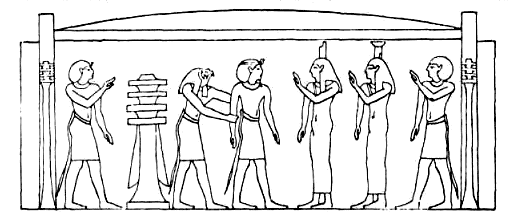
Fig. 24
The king's prayer to be given Everlastingness, a "Name," a Divine
Ladder, has been granted. He is about to begin his actual ascent to
the Heavens.
Though he requires only one Divine Ladder for himself, not one but
two Ascenders are raised together. Both the "Eye of Ra" and the "Eye
of Horus" are prepared and put into position, one on the "wing of
Thoth" and the other on the "wing of Seth," To the puzzled king, the
Gods explain that the second boat is for the "son of Aten," a God
descended of the Winged Disk—perhaps the God to whom the king had
spoken in the "equipping chamber":
The Eye of Horus is mounted
Upon the wing of Seth.
The cables are tied,
the boats are assembled,
That the son of the Aten
be not without a boat.
The king is with the son of Aten;
He is not without a boat.
"Equipped as a God," the king is assisted by two Goddesses "who
seize his cables" to step into the Eye of Horus. The term "Eye" (of
Horus, of Ra) which has gradually replaced the term Ascender or
Ladder, now is being increasingly displaced by the term "boat." The
"Eye" or "boat" into which the king steps in is 770 cubits (circa
1000 feet) long. A God who is in charge of the boat sits at its bow.
He is instructed:
"Take this king with thee in the cabin of thy
boat."
As the king "steps down into the perch"—a term denoting an elevated
resting place, especially of birds—he can see the face of the God
who is in the cabin, "for the face of the God is open." The king
"takes a seat in the divine boat" between two Gods; the seat is
called "Truth which makes alive." Two "horns" protrude from the
king's head (or helmet); "he attaches to himself that which went
forth from the head of Horus." He is plugged in for action.
The texts dealing with the Journey to the Afterlife by King Pepi
describe the moment:
"Pepi is arrayed in the apparel of Horus, and
in the dress of Thoth; Isis is before him and Nephtys is behind him;
Ap-uat who is Opener of the Ways hath opened a way unto him; Shu the
Sky Bearer hath lifted him up, the Gods of An make him ascend the
Stairway and set him before the Firmament of the Heaven; Nut the sky
Goddess extends her hand to him."
The magical moment has arrived; there are only two more doors to be
opened, and the king—as Ra and Osiris had done before—will emerge
triumphantly from the Duat and his boat will float on the Celestial
Waters. The king says a silent prayer:
"O Lofty one ... thou Door
of Heaven: the king has come to thee; cause this door to be opened
for him. ' The "two Ded pillars are standing" upright, motionless.
And suddenly "the double doors of heaven are open!"
The texts break out in ecstatic pronouncements:
The Door to Heaven is open!
The Door of Earth is open!
The aperture of the celestial windows is open!
The Stairway to Heaven is open;
The Steps of Light are revealed ...
The double Doors to Heaven are open;
The double doors of Khebhu are open
for Horus of the east,
at daybreak.
Ape-Gods symbolizing the waning
moon ("Daybreak") begin to pronounce magical "words of power which will cause splendor to
issue from the Eye of Horus." The "radiance"—reported earlier as the
hallmark of the twin-peaked Mountain of Light—intensifies:
The sky-God
has strengthened the radiance for the king
that the king may lift himself to Heaven
like the Eye of Ra.
The king is in this Eye of Horus,
where the command of the Gods is heard.
The "Eye of Horus" begins to change hues: first it is blue, then it
is red. There are excitement and much activity all around:
The red-Eye of Horus is furious in wrath, its might no one can
withstand. His messengers hurry, his runner hastens.
They announce to him who lifts up his arm
in the East: "let this one pass."
Let the God command the fathers,
the Gods:
"Be silent ... lay your hands upon your mouth ...
stand at the doorway of the horizon,
open the double doors (of
heaven)."
The silence is broken; now there are sound and fury, roaring and
quaking:
The Heaven speaks, the Earth quakes;
The Earth trembles;
The two
districts of the Gods shout;
The ground is come apart ...When the
king ascends to Heaven
when he ferries over the vault (to Heaven) ...
The Earth laughs, the Sky smiles
when the king ascends to Heaven.
Heaven shouts in joy for him;
The
Earth quakes for him.
The roaring tempest drives him,
it roars like Seth.
The guardians of Heaven's parts
open the doors of
Heaven for him.
Then "the two mountains divide,"
and there is a lift-off into a
cloudy sky of dawn
from which the stars of night are gone:
The sky is overcast,
the stars are darkened.
The bows are agitated,
the
bones of Earth quake.
Amid the agitation, quaking and thundering, the "Bull of Heaven"
("whose belly is full of magic") rises from the "Isle of Flame."
Then the agitation ceases; and the king is aloft—"dawning as a
falcon":
They see the king dawning as a falcon,
as a God;
To live with his
fathers,
to feed with his mothers ...
The king is a Bull of Heaven ...whose belly is full of magic
from
the Isle of Flame.
Utterance 422 speaks eloquently of this moment:
O this Pepi!
Thou hast departed!
Thou art a Glorious One,
mighty as a God, seated as Osiris!
Thy soul is within thee;
Thy Power ("Control") has thou behind thee;
The Misut-crown is at thy hand ...
Thou ascendest to thy mother, Goddess of Heaven
She lays hold of thine arm,
she shows thee the way to the horizon,
to the place where Ra is.
The double doors of heaven are opened for thee,
The double doors of the sky are opened for thee ...
Thou risest, O Pepi ... equipped as a God.
(An illustration in the tomb of Ramses IX suggests that the Double
Doors were opened by inclining them away from each other; this was
achieved by the manipulation of wheels and pulleys, operated by six
Gods at each door. Through the funnel-like opening, a giant man-like
falcon could then emerge. Fig. 25.)
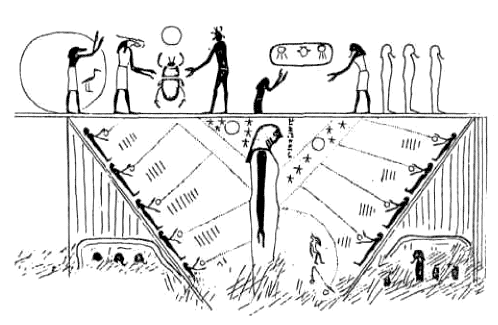
Fig. 25
With great self-satisfaction at the achievement, the texts announce
to the king's subjects: "He flies who flies; this king Pepi flies
away from you, ye mortals. He is not of the Earth, he is of the
Heaven... This king Pepi flies as a cloud to the sky, like a
masthead bird; this king Pepi kisses the sky like a falcon; he
reaches the sky of the Horizon God." The king, the Pyramid Texts continue, is now "on the Sky-Bearer, the upholder of
the stars; from within the shadow of the Walls of God, he crosses
the skies."
The king is not simply skyborne, he is orbiting Earth:
He encompasses the sky like Ra,
He traverses the sky like Thoth ...
He traveleth over the regions of Horus,
He traveleth over the
regions of Seth ...
He has completely encircled twice the heavens,
He has revolved about the two lands ...
The king is a
falcon surpassing the falcons;
He is a Great Falcon.
(A verse also states that the king "crosses the sky like
Sunt, which
crosses the sky nine times in one night"; but the meaning of Sunt
and thus the comparison are as yet undeciphered.)
Still sitting between "these two companions who voyage over the
sky," the king soars toward the eastern horizon, far far away in the
heavens. His destination is the Aten, the Winged Disk, which is also
called the Imperishable Star. The prayers now focus on getting the
king to the Aten and his safe arrival upon it: "Aten, let him ascend
to thee; enfold him in thine embrace," the texts intone in behalf of
the king. There is the abode of Ra, and the prayers seek to assure a
favorable welcome for the king, by presenting his arrival at the
Celestial Abode as the return of a son to his father:
Ra of the Aten,
Thy son has come to thee;
Pepi comes to thee;
Let him
ascend to thee;
Enfold him in thy embrace.
Now "there is clamor in Heaven: 'We see a new thing' say the
celestial Gods; a Horus is in the rays of Ra.'" The king—"on his way
to Heaven, on the wind"—"advances in Heaven, he cleaves its
firmament," expecting a welcome at his destination.
The celestial journey is to last eight days: "When the hour of the
morrow comes, the hour of the eighth day, the king will be summoned
by Ra"; the Gods who guard the entrance to the Aten or to Ra's abode
there will let him through, for Ra himself shall await the king on
the Imperishable Star:
When this hour of the morrow comes ...
When the king shall stand there, on the star
which is on the underside of the Heaven,
he shall be judged as a God,
listened to like a prince The king shall call out to them;
They shall come to him, those four Gods
who stand on the Dam-scepters of Heaven,
that they may speak the king's name to Ra,
announce his name Horus of the Horizons:
"He has come to thee!
"The king has come to thee!"
Traveling in "the lake that is the heavens," the king nears "the
shores of the sky." As he approaches, the Gods on the Imperishable
Star indeed announce as expected: "The arriver comes ... Ra has
given him his arm on the Stairway to Heaven. He Who Knows The Place'
comes, say the Gods." There, at the gates of the Double Palace, Ra
is indeed awaiting the king:
Thou findest Ra standing there;
He greets thee, lays hold on thy
arm;
He leads thee into the celestial Double Palace;
He places thee
upon the throne of Osiris.
And the texts announce:
"Ra has taken the king to himself, to
Heaven, on the eastern side of Heaven ... the king is on that star
which radiates in Heaven."
Now there is one more detail left to accomplish. In the company of
"Horus of the Duat," described as "the great green divine falcon,"
the king sets out to find the Tree of Life in the midst of the Place
of Offering.
"This king Pepi goes to the Field of Life, the
birthplace of Ra in the heavens. He finds Kebehet approaching him
with these four jars with which she refreshes the heart of the Great
God on the day when he awakes. She refreshes the heart of this king
Pepi therewith to Life."
Mission achieved, the texts announce with glee:
Ho, this Pepi!
All satisfying life is given to thee;
"Eternity is thine," says Ra ...
Thou perishest not, thou passest
not away for ever and ever.
The king has ascended the Stairway to Heaven; he has reached the
Imperishable Star; "his lifetime is eternity, its limit
everlastingness."
Back to Contents
|










 symbolically reaching
toward the
Celestial Disk in the heavens—in the shape of a high tower with a
superstructure (Fig. 23a, b). In stylized form, the tower by itself
was
written hieroglyphic-ally
symbolically reaching
toward the
Celestial Disk in the heavens—in the shape of a high tower with a
superstructure (Fig. 23a, b). In stylized form, the tower by itself
was
written hieroglyphic-ally  ("Ded") and meant "Everlastingness." It
was a
symbol most closely associated with Osiris, for a pair of such
pillars
("Ded") and meant "Everlastingness." It
was a
symbol most closely associated with Osiris, for a pair of such
pillars
 were said to have been erected in front of his principal temple at Abydos, to commemorate the two objects which stood in the Land of
Seker and made possible the ascent of Osiris heavenward.
were said to have been erected in front of his principal temple at Abydos, to commemorate the two objects which stood in the Land of
Seker and made possible the ascent of Osiris heavenward. 

